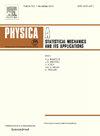Improving community detection in blockmodel by distance-based observation selection
IF 2.8
3区 物理与天体物理
Q2 PHYSICS, MULTIDISCIPLINARY
Physica A: Statistical Mechanics and its Applications
Pub Date : 2024-09-24
DOI:10.1016/j.physa.2024.130125
引用次数: 0
Abstract
Community detection is an important research topic in complex systems and has plenty of applications in real-world networks. Probabilistic methods, such as the Expectation–Maximization (EM), are developed to classify nodes that have similar connection patterns in a network based on blockmodels. However, the detection procedures in these models are typically started from randomly generated initial community distributions without prior knowledge. In biological and social networks, there are practical measures to obtain prior knowledge for a subset of nodes, such as local observations. These facts lead us to question how we can select a subset of nodes with known community labels to enhance the accuracy of the EM method. The current selection methods lack the relationship between detection accuracy and structural characteristics and most approaches consider the nodes as the center of communities, which is not suitable for block models. In this paper, we first study the relationships between the structural distance and detection accuracy without prior knowledge. Then we propose a distance-based indicator to describe the performance of the observation node set in the EM method. Finally, we introduce a scoring method based on the indicator to select a partial observation set, improving the accuracy of community detection using the EM method. Empirical results from synthetic and real-world networks corroborate that the proposed indicator could contribute to a better performance in kinds of scenarios.
通过基于距离的观测选择改进块模型中的群落检测
群落检测是复杂系统中的一个重要研究课题,在现实世界的网络中有大量应用。人们开发了一些概率方法,如期望最大化法(EM),用于根据块模型对网络中具有相似连接模式的节点进行分类。然而,这些模型中的检测程序通常是从随机生成的初始群落分布开始的,没有先验知识。在生物和社会网络中,有一些实用的方法可以获得节点子集的先验知识,例如局部观测。这些事实引发了我们的疑问:如何选择具有已知社区标签的节点子集,以提高 EM 方法的准确性?目前的选择方法缺乏检测精度与结构特征之间的关系,而且大多数方法都将节点视为群落的中心,这并不适合块模型。在本文中,我们首先研究了结构距离与检测精度之间的关系,而不需要先验知识。然后,我们提出了一种基于距离的指标来描述 EM 方法中观测节点集的性能。最后,我们引入了一种基于该指标的评分方法来选择部分观测集,从而提高使用 EM 方法进行群落检测的准确性。来自合成网络和真实世界网络的经验结果证实,所提出的指标在各种情况下都能帮助提高性能。
本文章由计算机程序翻译,如有差异,请以英文原文为准。
求助全文
约1分钟内获得全文
求助全文
来源期刊
CiteScore
7.20
自引率
9.10%
发文量
852
审稿时长
6.6 months
期刊介绍:
Physica A: Statistical Mechanics and its Applications
Recognized by the European Physical Society
Physica A publishes research in the field of statistical mechanics and its applications.
Statistical mechanics sets out to explain the behaviour of macroscopic systems by studying the statistical properties of their microscopic constituents.
Applications of the techniques of statistical mechanics are widespread, and include: applications to physical systems such as solids, liquids and gases; applications to chemical and biological systems (colloids, interfaces, complex fluids, polymers and biopolymers, cell physics); and other interdisciplinary applications to for instance biological, economical and sociological systems.

 求助内容:
求助内容: 应助结果提醒方式:
应助结果提醒方式:


